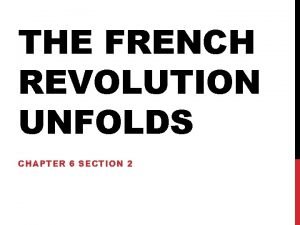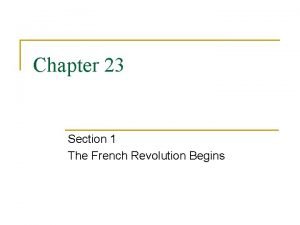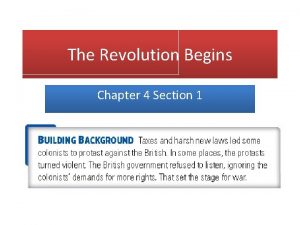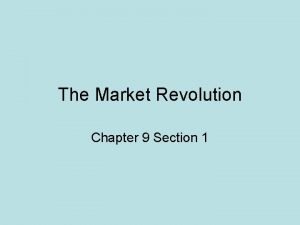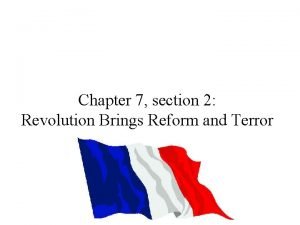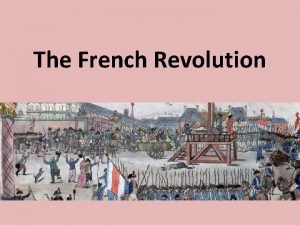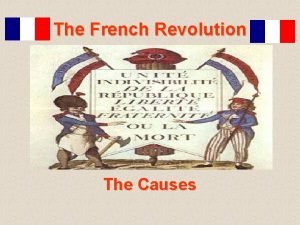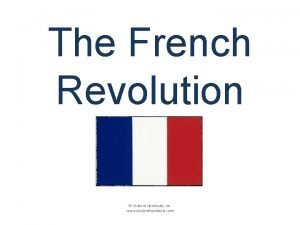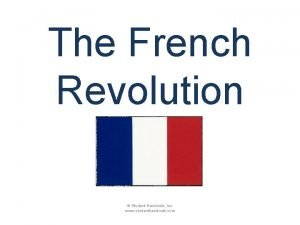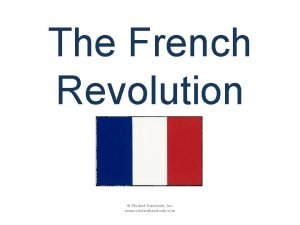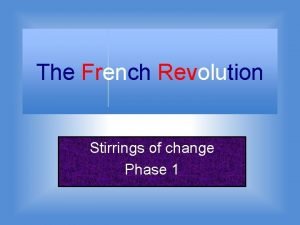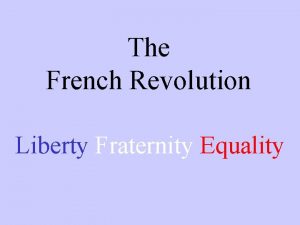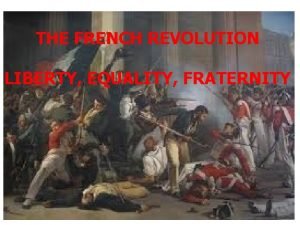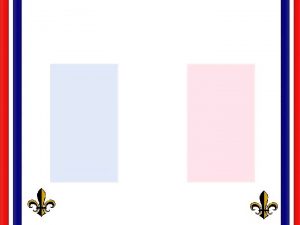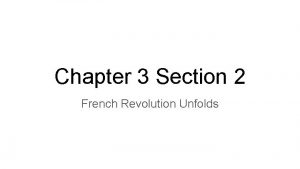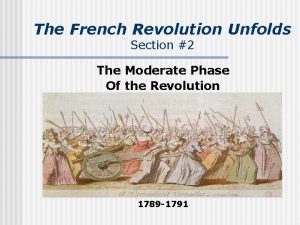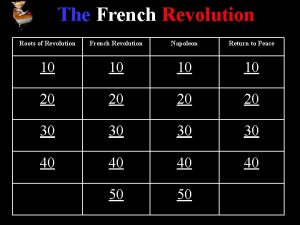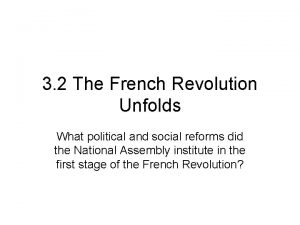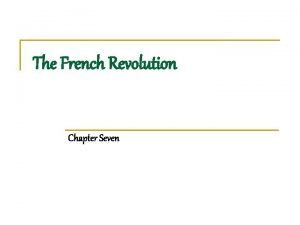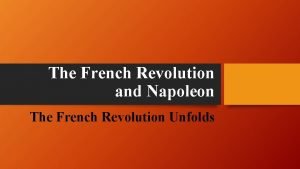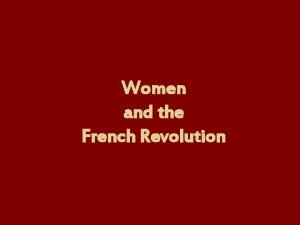The French Revolution Unfolds Chapter 3 Section 2



































- Slides: 35

The French Revolution Unfolds Chapter 3 Section 2

Video Go to www. khanacademy. org In the box “search for a video or topic” at the top of the page, type “French Revolution” A series of videos will appear Click on “French Revolution (Part 2)” Watch the video Read the remainder of this Power. Point Answer the Power. Point questions for homework

What were the four phases of the French Revolution called? Moderate Phase—National Assembly turned France into a constitutional monarchy (1789 -1791) Radical Phase—Escalating violence, end of monarchy, and Reign of Terror (1792 -1794) Age of the Directory (1796 -1799) Age of Napoleon (1799 -1815)

What were economic conditions like in 1789? Starving peasants 1000 s of unemployed persons in search of work Rising grain prices (80% of income spent on bread alone)

“Great Fear” Rumors caused a “Great Fear”, or panic, to sweep across France Rumors spread of government attacks on peasants and villagers and seizures of peasant crops. In retaliation, peasants attacked nobles and their homes, burned records, and seized grain Great Fear

Paris Commune Paris, capital of France, was center of revolutionary activity Different groups, or factions, competed for political power Moderates looked to Marquis de Lafayette for leadership (Lafayette assisted Washington in American Revolution) Lafayette organized the National Guard in response to king’s royal troops A radical political group known as Paris Commune replaced the Paris government More political clubs developed and demanded 1) end to the monarchy and they 2) spread wild rumors about royal family

France

Marquis de Lafayette He was a French leader who assisted George Washington during the American Revolution.

What changes occurred in the National Assembly (formerly the Third Estate)? A meeting was held on August 4, 1789 Nobles surrendered their right to collect dues from peasants, exclusive hunting rights, special legal status, and exemption from paying taxes The National Assembly made the above reforms into law and achieved a key Enlightenment goal: “THE EQUALITY OF ALL MALE CITIZENS BEFORE THE LAW” (sorry – females still not included at that time)

National Assembly

What was the Declaration of the Rights of Man and the Citizen? The National Assembly published this document It was modeled after the U. S. Declaration of Independence All French men “born and remain free and equal in rights”

Declaration of the Rights of Man and the Citizen • Natural rights include “liberty, property, security, and resistance to oppression” • Governments must exist to protect the natural rights of citizens (hey, remember John Locke? ? ) • All male citizens equal before the law, freedom of religion, and taxes according to one’s ability to pay

Slogan of the French Revolution “LIBERTY, EQUALITY, FRATERNITY” (sorry, but not for women)

Olympe de Gouges She was a female journalist who demanded rights for women She authored a similar document - Declaration of the Rights of Women and the Female Citizen

Women’s March on Versailles (October 5, 1789) 6, 000 angry women marched 13 miles in rain from Paris to king’s palace at Versailles The Women demanded 1) bread and 2) to personally see King Louis XVI They had no food to feed their families!! The monarchs and their family left for Paris followed by the angry women Royal family was imprisoned in the Tuileries Palace in Paris

Women’s March on Versailles These angry women are marching with pitchforks and a cannon!!

Why did women HATE Queen Marie Antoinette? ? Common women hated Queen Marie Antoniette, who spent huge sums of money on herself (clothing, jewelry, perfumes) while ignoring the poor, starving citizens of France n

Versailles Palace

How did the National Assembly Pay Off France’s Huge Debts? 1) Assembly voted to take over and sell church lands to raise money 2) National Assembly put French Catholic Church under state control (church was not happy about this) 3) Bishops and priests were elected and salaried – not appointed anymore 4) Constitution ended papal (pope’s) authority over French Church (the pope was furious!!) 5) Convents and monasteries were dissolved

Reaction to National Assembly’s Authority Over Church Bishops and priests refused to accept new Civil Constitution Pope condemned the new constitution Many religious French peasants rejected the changes Government punished clergy who refused to support the Civil Constitution

Constitution of 1791 The absolute monarchy was replaced by a limited monarchy New Legislative Assembly had power to make laws, collect taxes, and decide issues of war and peace Lawmakers would be elected by tax-paying male citizens over age 25 Old provinces replaced with 83 departments (counties) of equal size

French Departments (counties)

King Louis Attempts to Escape King and family attempted escape in June, 1791 The escape attempt failed as the monarchs tried to cross the border At the border, a guard recognized the king’s face from paper currency The This royal family was escorted back to Paris escape attempt made Louis XVI appear to be a traitor to the Revolution

King Louis XVI of France He did not care at all about the problems of the French people. He lacked leadership. He lacked the political and economic skills to govern France effectively.

How did European rulers react to the French Revolution? European rulers did not want French Revolution to spill across the border and spark similar revolutions in their countries Emigres (nobles, clergy, and others who fled the Revolution to other countries) reported attacks on their privileges, property, their religion, and their lives European rulers did not want “revolutionary ideas” to “infect” their populations

Map of Europe Eve of French Revolution

The Declaration of Pilnitz king of Prussia and Emperor of Austria jointly issued the Declaration of Pilnitz Under this declaration, these monarchs threatened to intervene to protect the French monarchy (protecting and restoring the French monarchy would prevent the French Revolution from spreading to other European countries) Other European monarchs did not want the French Revolution to incite violence in their countries!! The French revolutionaries viewed this declaration as a threat against the revolution

Why did the Legislative Assembly fail? Lasted one year amidst new economic problems: Assignats (currency) dropped in value Prices rose rapidly People selfishly hoarded food and supplies Significant food shortages

Sans-Culottes (“without breeches”) Another radical revolutionary group They wore long trousers The Sans-Culottes demanded a republic (government ruled by elected representatives) instead of a monarchy (government ruled by king and queen)

Hostile Political Factions Sans-culottes found support in Legislative Assembly among the Jacobins, a revolutionary political club Mostly middle-class lawyers or intellectuals Jacobins used power of newspapers to spread revolutionary ideas

War on Tyranny A war of words between French revolutionaries and European monarchs erupted into battlefield war The French Legislative Assembly declared war on Austria, Prussia, and Britain - to spread the revolution!! The great European powers expected an easy victory against France But the fighting began in 1792 and lasted until 1815

Powerpoint Questions 1. What was the document the French Revolutionaries issued that was similar to the U. S. Declaration of Independence? 2. Why did angry peasant women march on the Palace of Versailles? What were they demanding? 3. Who were the emigres? 4. Dressed as servants, what did King Louis XVI and Queen Marie Antoinette attempt to do? What was the result? Were they successful? 5. Who were the most radical elements of the revolution? What was their name?

Powerpoint Questions 6. What was the slogan of the French Revolution? 7. What did other European rulers fear about the French Revolution? 8. What was the Declaration of Pilnitz? Who issued this declaration? 9. Who were the sans-culottes? What did the sans-culottes demand? 10. Why did common women HATE Queen Marie Antoninette?

NEXT EPISODE Stay tuned for the next episode of the French Revolution…. ”Radical Days of the Revolution”

The End
 Chapter 6 section 2 the french revolution unfolds
Chapter 6 section 2 the french revolution unfolds The french revolution unfolds
The french revolution unfolds The french revolution begins chapter 7 section 1
The french revolution begins chapter 7 section 1 The french revolution begins chapter 23 section 1
The french revolution begins chapter 23 section 1 Russian revolution vs french revolution
Russian revolution vs french revolution You should hope this game will be over soon
You should hope this game will be over soon The french revolution and napoleon section 3 quiz
The french revolution and napoleon section 3 quiz Chapter 11 the french revolution and napoleon
Chapter 11 the french revolution and napoleon Chapter 23 the french revolution and napoleon
Chapter 23 the french revolution and napoleon Chapter 11 the french revolution and napoleon
Chapter 11 the french revolution and napoleon Chapter 6 the scientific revolution
Chapter 6 the scientific revolution Chapter 6 section 4 the american revolution
Chapter 6 section 4 the american revolution Chapter 18 section 3 radical days of the revolution
Chapter 18 section 3 radical days of the revolution Chapter 4 section 1 the revolution begins
Chapter 4 section 1 the revolution begins Chapter 9 section 1 the market revolution
Chapter 9 section 1 the market revolution Chapter 6 section 4
Chapter 6 section 4 Chapter 7 section 2 revolution brings reform and terror
Chapter 7 section 2 revolution brings reform and terror Chapter 23 section 2 revolution brings reform and terror
Chapter 23 section 2 revolution brings reform and terror Third agricultural revolution definition
Third agricultural revolution definition Grindstone french revolution
Grindstone french revolution Causes and effects of french revolution
Causes and effects of french revolution France monarchy timeline
France monarchy timeline French revolution calender
French revolution calender Explain the causes of french revolution
Explain the causes of french revolution Four stages of the french revolution
Four stages of the french revolution Short term causes of the french revolution
Short term causes of the french revolution Short term causes of the french revolution
Short term causes of the french revolution The effects of the french revolution
The effects of the french revolution October 6 1789 french revolution
October 6 1789 french revolution Causes of french revolution
Causes of french revolution N
N Fraternity in french revolution
Fraternity in french revolution Third estate french revolution
Third estate french revolution What were the four phases of the french revolution
What were the four phases of the french revolution French revolution causes
French revolution causes French revolution political cartoon assignment
French revolution political cartoon assignment
